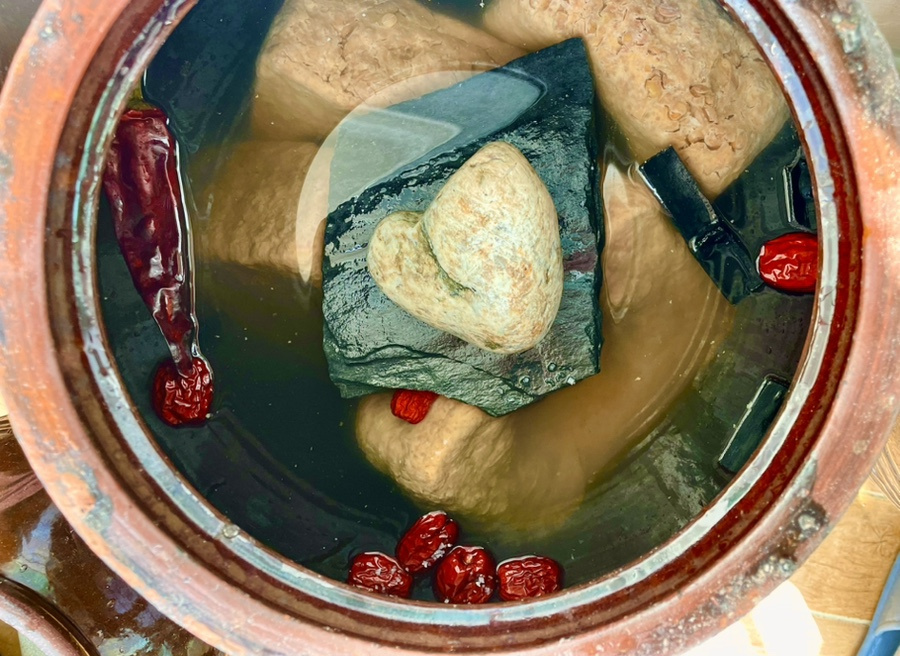Authentic Handmade Doenjang (Fermented Soybean Paste)
How to Make Soy Sauce and Doenjang from Meju in Your Apartment Balcony

For over 10 years, I’ve been fermenting my own soy sauce and doenjang right on my apartment balcony! Nowadays, with convenient kits that include water, salt, charcoal, and dried chili peppers, anyone can easily make delicious fermented sauces. I use GOMSO sun-dried sea salt that has been aged for 3-4 years to remove excess saltiness, which makes my soy sauce even more flavorful. It’s fascinating to watch the initially clear soy sauce gradually turn a rich brown as it matures. Once the meju (fermented soybean blocks) are removed, they become the base for delicious doenjang. Removing the meju after about a month and a half preserves more of its savory essence for the doenjang, while waiting two months allows the soy sauce to deepen its flavor. Around 40-50 days, on an auspicious ‘Son-eopneun Nal’ (a day without bad spirits), you can remove the meju to make doenjang, thus creating both soy sauce and doenjang simultaneously. Even though it’s made on a balcony, the soy sauce and doenjang I make are at least ten times tastier than store-bought versions! I learned this craft from my mother-in-law, and now I share my homemade fermented sauces with her, and she absolutely loves the taste!
Key Ingredients- 6 blocks of well-dried Meju (fermented soybean blocks)
- 17 liters of natural or purified water
- 3.5-4 liters of sun-dried sea salt (aged 3-4 years to remove harshness)
- 5 pieces of charcoal
- 2 dried chili peppers
- 10 dates (seedless)
Cooking Instructions
Step 1
About a week before you plan to make the soy sauce and doenjang, thoroughly wipe the meju blocks with a dry cloth to remove any dust. Then, place them in a warm, well-ventilated area indoors, like a living room, for a week to thoroughly dry the surface. This drying process helps prevent mold and deepens the flavor of the fermented products.

Step 2
It’s crucial to thoroughly clean your fermentation vessel (onggi or jar) before use. First, scrub it clean with a mixture of baking soda and water using a soft brush. Then, sterilize it by boiling water with a splash of vinegar. After sterilizing, let it dry completely in the sun until there is no moisture left.

Step 3
Gently rinse the dried meju blocks under running water to remove surface dust and any unwanted mold. Be careful not to wash for too long, as this can leach out the delicious components of the meju. After rinsing, pat the meju dry and let it cool down slightly.

Step 4
Prepare 17 liters of clean natural or purified water in large containers or pots. You can adjust the water quantity based on the size of your fermentation vessel. Ensure the containers are clean before filling them with water.

Step 5
Dissolve the sun-dried sea salt in the prepared water to create the brine. A ratio of 3.5 liters of salt to 16 liters of water will result in a brine concentration of approximately 20-23%, which is ideal. Stir thoroughly until all the salt is completely dissolved without any lumps. Using salt that has been aged for 3-4 years is recommended to avoid bitterness and achieve a rich flavor. It’s best to dissolve the salt in batches rather than all at once, making it easier to adjust the concentration later.

Step 6
Place a fine-mesh sieve lined with a clean cheesecloth over the opening of your fermentation vessel. Carefully pour the dissolved brine through the sieve into the vessel. This step filters out any impurities while filling the jar.

Step 7
Prepare the ingredients that will help the fermentation process: an egg, dried chili peppers, charcoal pieces, and dates. Charcoal helps inhibit the growth of unwanted bacteria and adds a pleasant aroma, while dried chili peppers act as preservatives and add a hint of spice. Dates contribute sweetness and depth of flavor. Gently rinse these ingredients under running water.

Step 8
The best way to check the salt concentration is by using the egg test. Carefully float the egg in the brine. If about the size of a 500-won coin (a Korean coin, roughly the size of a US quarter) of the egg is visible above the surface, the salinity is just right for fermentation. If more of the egg floats, the brine is too salty; add a little more water. If the egg sinks too much, the brine is too weak; dissolve more salt in a separate small amount of water and add it gradually, stirring, until the correct salinity is achieved.

Step 9
Once the brine’s salinity is adjusted, add the rinsed charcoal pieces, dried chili peppers, and dates to the jar. These ingredients will impart subtle flavors to the soy sauce and doenjang as they mature.

Step 10
After placing the meju blocks into the jar, it’s essential to keep them submerged in the brine. You can use a bamboo rack or place clean, sterilized heavy stones (like smooth river rocks or decorative stones) on top of the meju to hold them down. This prevents the meju from being exposed to air and spoiling.

Step 11
Finally, cover the opening of the jar with cheesecloth or plastic wrap and seal it tightly with a rubber band. This allows for air circulation while preventing insects and other contaminants from entering. Be especially careful to seal it securely during warmer months to keep pests away. Now, all that’s left is to wait patiently for your delicious fermented sauces to mature!




